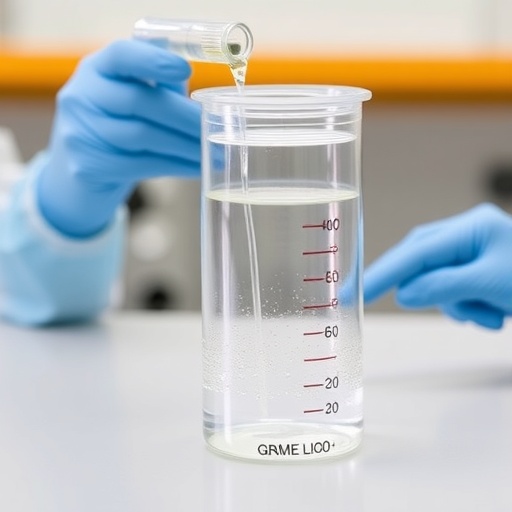
Scientists at King’s College London have developed a groundbreaking technique to characterize graphene oxide (GO) that promises to revolutionize quality control in nanomaterials. This novel approach, termed ‘interactional fingerprinting,’ offers a faster, cheaper, and more accessible alternative to the expensive and time-consuming gold-standard analyses currently used in the field. By emulating the sensory abilities of human taste and smell, the method generates a unique molecular signature for each sample, potentially accelerating the transition of graphene oxide from experimental labs to commercial applications.
Graphene oxide, an oxidized form of graphene, has garnered significant attention due to its exceptional properties such as mechanical strength, electrical conductivity, and versatile chemical functionality. However, its inconsistent production and complex characterization have stalled wider commercialization. Traditional high-precision analyses often require costly instrumentation and expertise, limiting their availability. The new interactional fingerprinting method addresses this by using a suite of fluorescent molecular probes that respond sensitively to subtle variations in the chemistry and morphology of graphene oxide samples.
The technique functions by dispersing microgram quantities of graphene oxide in aqueous solutions, followed by exposure to a series of custom-designed fluorescent probes. These molecular sensors emit light at specific wavelengths but alter their fluorescence upon interaction with the GO surface. Because each probe is tuned to detect particular attributes such as oxygen functional group content or flake size, the composite fluorescence pattern serves as a multidimensional interaction profile. Advanced data processing techniques then translate this pattern into a distinctive, reproducible ‘fingerprint’ for each sample.
.adsslot_tDaMu3dj5V{width:728px !important;height:90px !important;}
@media(max-width:1199px){ .adsslot_tDaMu3dj5V{width:468px !important;height:60px !important;}
}
@media(max-width:767px){ .adsslot_tDaMu3dj5V{width:320px !important;height:50px !important;}
}
ADVERTISEMENT
This interactional fingerprinting enables rapid discrimination between different batches of GO, highlighting variations that can arise from production inconsistencies or degradation during storage. Such rapid, high-throughput characterization was previously unattainable without dedicating extensive resources over protracted timeframes. By reducing sample preparation and analysis time from weeks to mere hours, the methodology empowers researchers and manufacturers to perform on-site quality control using routine laboratory equipment, eliminating the bottlenecks imposed by specialized instruments.
The implications extend beyond quality assurance. Reliable characterization accelerates innovation in next-generation technologies, including sustainable electronics and advanced battery materials where graphene oxide’s tunable electrical and chemical features are critical. By providing a standardized and accessible tool for verifying batch consistency, the method addresses one of the key impediments hindering the scalable industrial adoption of graphene oxide.
This advancement comes against a backdrop of significant investment in graphene-related research infrastructure, such as the Graphene Engineering Innovation Centre and National Graphene Institute in the UK, which have collectively garnered over £180 million to push graphene into markets ranging from energy storage to personal protective equipment. Yet, despite the celebrated Nobel Prize-winning discovery of graphene in 2010, the field has struggled with quality control challenges due to varying sample composition and the limited availability of characterization instrumentation.
Previous studies have underscored the unreliability in commercial graphene supplies, with reports indicating that many products labeled as graphene on the market were, in fact, impure or misclassified powders. Similar concerns plague graphene oxide, where minute changes in oxygenation and flake size critically impact material properties. Without accessible and reliable quality metrics, researchers and developers face unpredictable results, hindering reproducibility and confidence in materials.
The molecular probe-based approach is elegantly simple yet highly effective. By selecting fluorescent molecules tailored to interact predictably with specific surface chemistries, the system translates complex nanoscale variations into easily measurable optical signals. These signals, processed through mathematical algorithms, create a multidimensional map analogous to a biological fingerprint. Crucially, the process avoids reliance on expensive characterization techniques such as X-ray Photoelectron Spectroscopy (XPS) or Transmission Electron Microscopy (TEM), which remain prohibitive for routine analysis.
Dr. Andrew Surman, senior lecturer and lead author of the study, highlights the practical benefits: the ability to confirm batch-to-batch consistency swiftly is critical for advancing graphene oxide technologies. The interactional fingerprinting supports iterative experimentation and manufacturing improvements by pinpointing sources of variation. This empowers companies and academic groups alike to allocate resources more efficiently, accelerating the development pipeline.
Beyond graphene oxide, the research team envisions applying this molecular probe methodology to other two-dimensional materials, such as borophene and transition metal dichalcogenides, which are similarly hampered by challenges in rapid characterization. Introducing a universal, cost-effective screening tool stands to broaden the accessible materials science toolkit, fostering innovation in a range of emergent nanotechnologies.
The research, published in the Journal of the American Chemical Society, represents a critical step in democratizing advanced material characterization. The approach’s compatibility with existing lab infrastructure ensures swift adoption and has the potential to redefine quality control standards within the graphene materials supply chain. Through this, the pathway to commercial exploitation of graphene oxide and related materials becomes markedly clearer and more achievable.
Ultimately, the interactional fingerprinting technique not only addresses pressing practical issues but also exemplifies how bioinspired methods can provide elegant solutions to complex scientific challenges. By harnessing molecular sensitivity and data-driven interpretation, scientists are bridging the gap between experimental potential and industry-scale application, propelling the promise of graphene-based technologies closer to industrial reality.
Subject of Research: Graphene Oxide Characterization and Quality Control
Article Title: Interactional Fingerprinting: A Novel Molecular Probe Technique for Rapid, Cost-Effective Characterization of Graphene Oxide
News Publication Date: Not specified
Web References:
– https://pubmed.ncbi.nlm.nih.gov/30349123/
– https://www.nature.com/articles/s41598-023-33350-5
– https://pubs.acs.org/doi/10.1021/jacs.5c05355
References: Journal of the American Chemical Society (JACS)
Image Credits: Not specified
Keywords
Graphene, Graphene Oxide, Analytical Chemistry, Chemical Engineering, Carbon Allotropes, Molecular Probes, Nanomaterials Characterization, Quality Control, Fluorescence Spectroscopy, Materials Science, Nanotechnology, Bioinspired Sensing
Tags: advancements in nanotechnology quality assessmentaffordable graphene analysiscommercial applications of grapheneelectrical conductivity of graphenefluorescent molecular probesgraphene oxide quality controlinnovative sensing methods in chemistryinteractional fingerprinting techniquemechanical strength of graphene oxidenanomaterials characterization methodsoptimizing graphene oxide productiontransition from lab to market for nanomaterials





